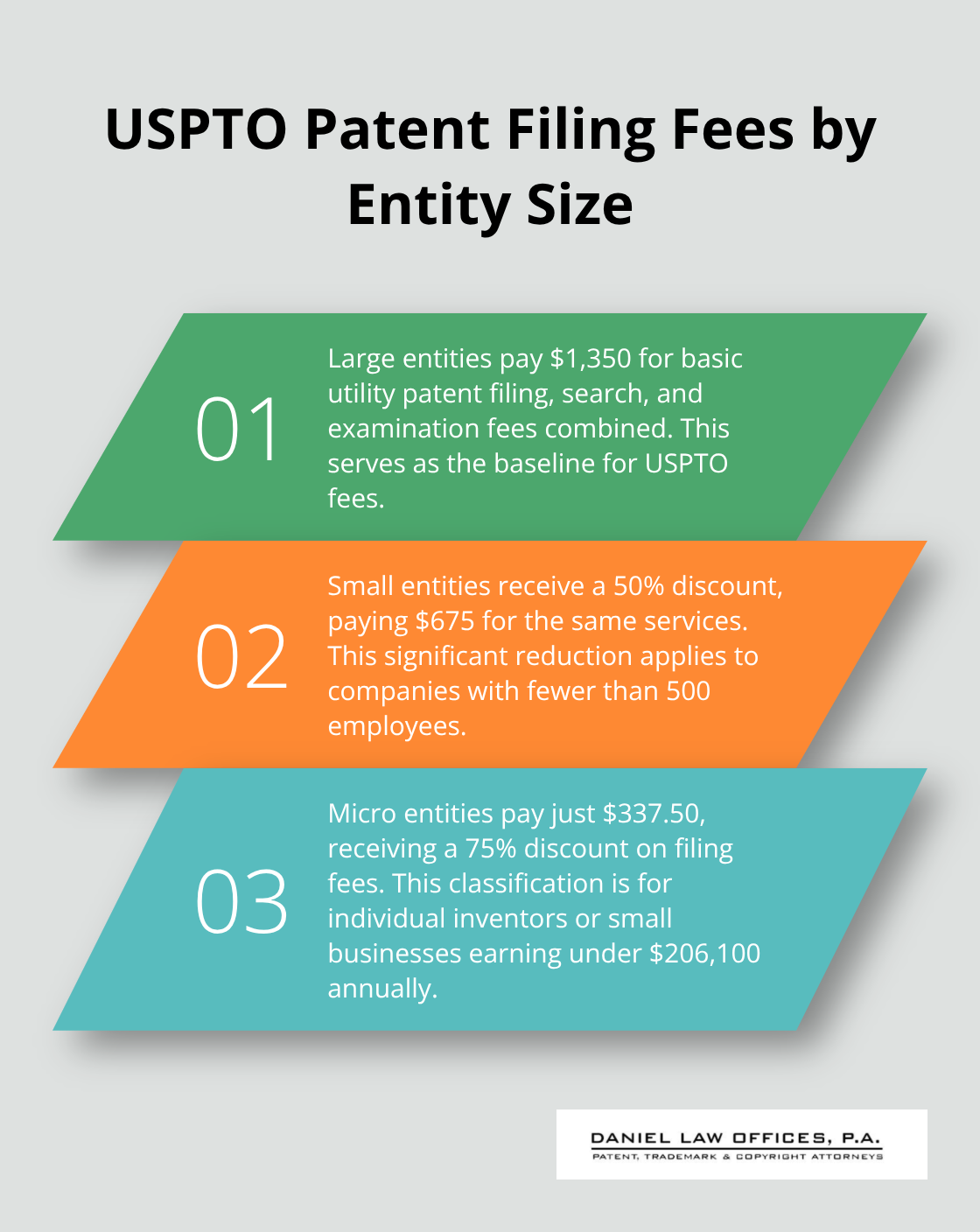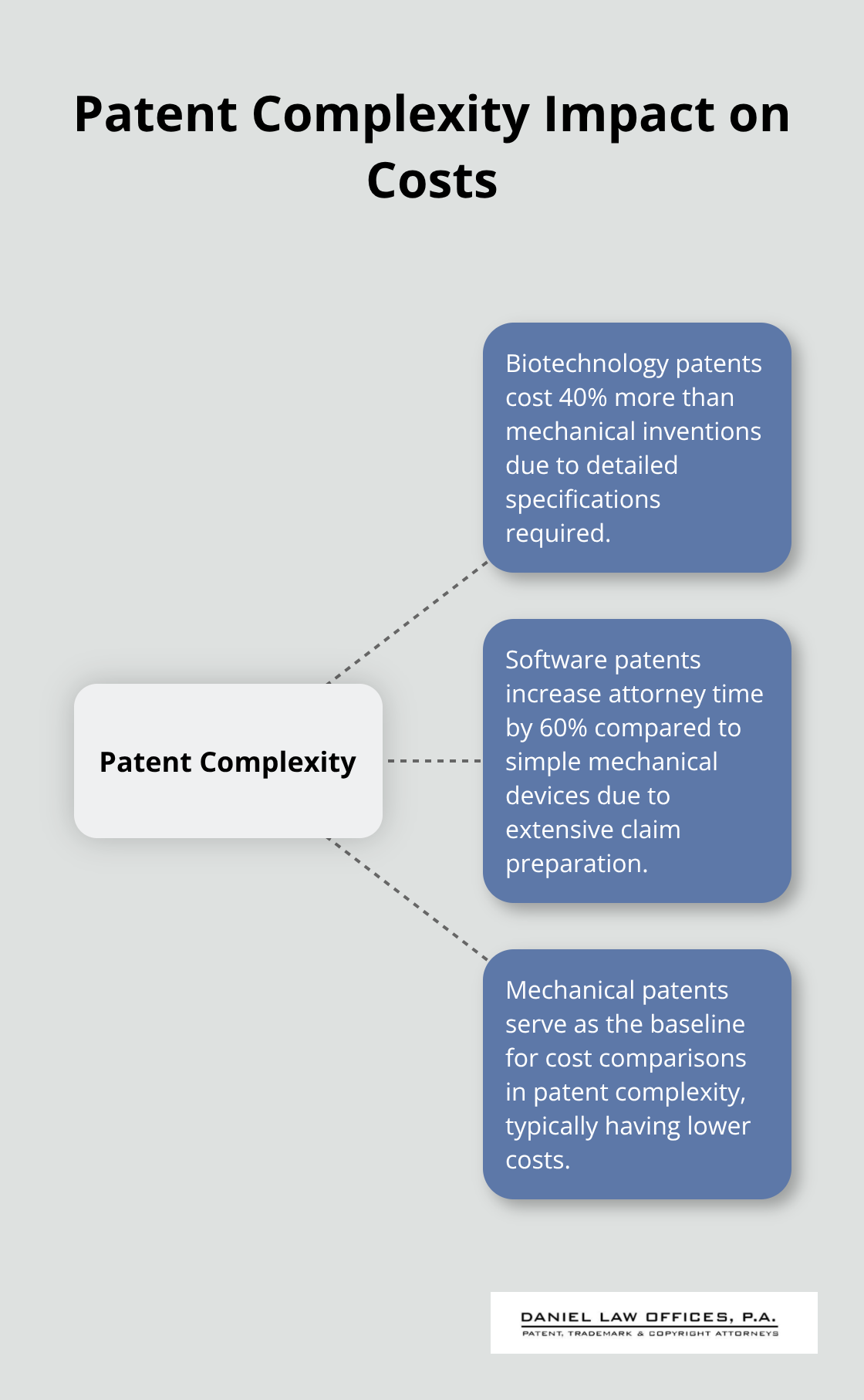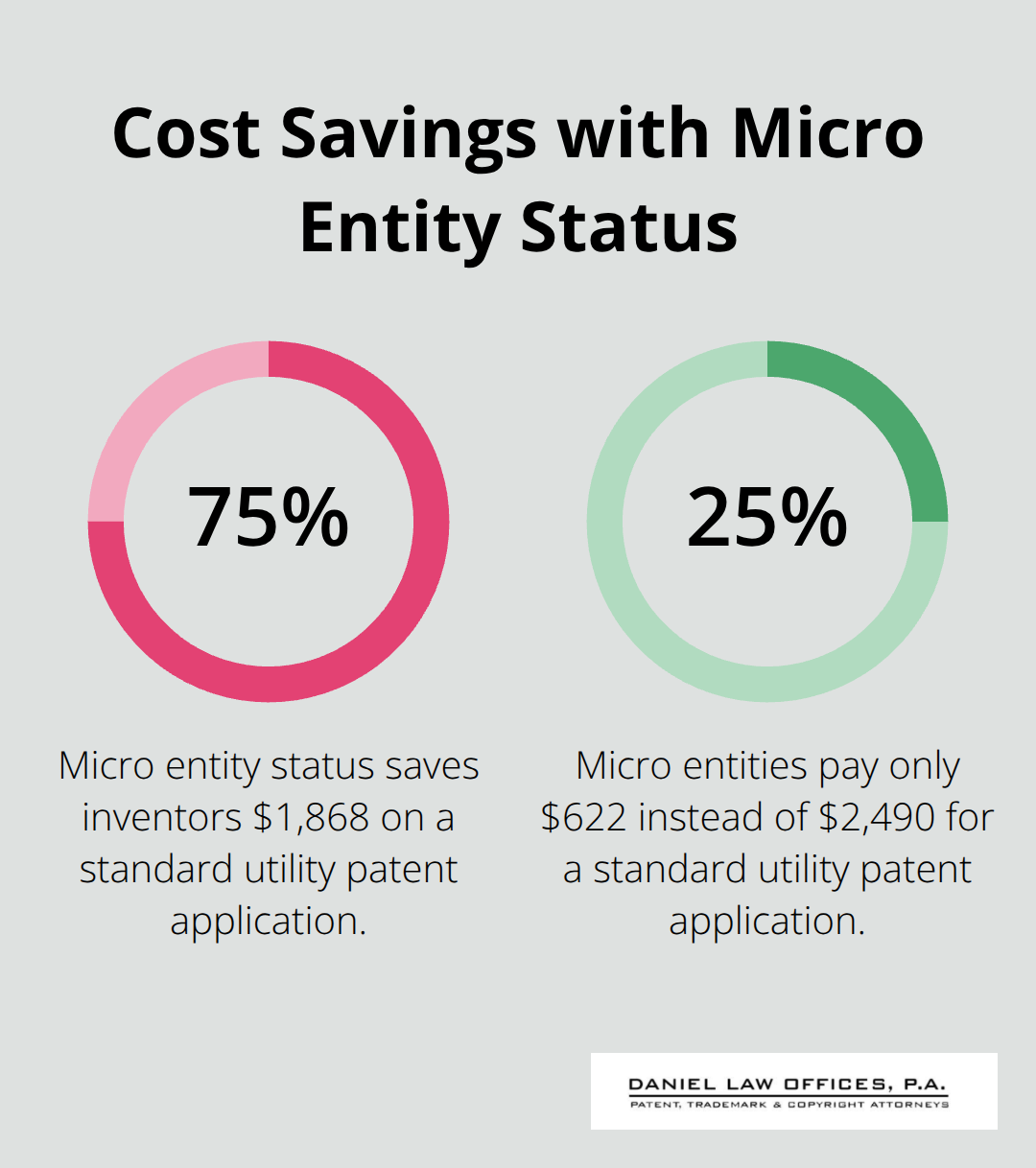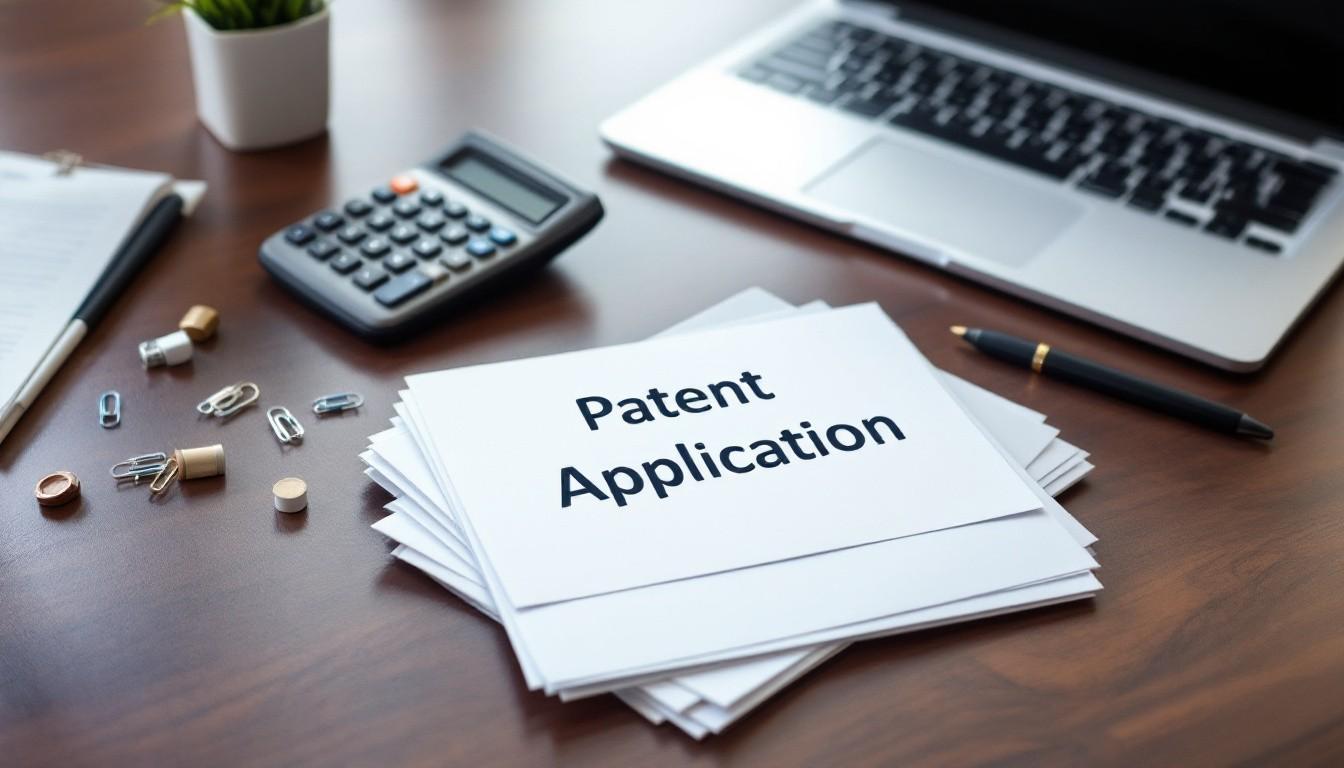Patent Filing Fees in Orlando, Florida A Comprehensive Overview
Patent filing fees can range from hundreds to thousands of dollars depending on your entity size and application complexity. The USPTO fee structure includes basic filing costs, search fees, examination charges, and additional expenses for extra claims or drawings.
We at Daniel Law Offices, P.A. break down these costs to help inventors and businesses budget effectively for patent protection. Understanding fee categories and available discounts makes the difference between overpaying and strategic patent investment.
What Do USPTO Filing Fees Actually Cost?
Entity Size Determines Your Base Costs
The USPTO charges dramatically different rates based on your entity classification. Large entities pay $1,350 for basic utility patent filing, search, and examination fees combined. Small entities receive a 50% discount at $675, while micro entities pay just $337.50 for the same services.
These classifications depend on your company size and annual revenue. Micro entity status requires individual inventors or businesses that earn under $206,100 annually according to USPTO guidelines. Small entity status applies to companies with fewer than 500 employees, while large entity classification covers major corporations.

The USPTO reports that 8% of applications face rejection due to incorrect entity status claims. This results in penalty fees and processing delays. Electronic filing saves an additional $400 paper filing surcharge that applies to all physical submissions.
Additional Costs Add Up Fast
Standard utility patents include three independent claims and 20 total claims without extra charges. Each independent claim beyond three costs $600 for large entities, $240 for small entities, and $120 for micro entities. Claims that exceed 20 trigger $200 fees per additional claim for large entities (with proportional reductions for smaller classifications).
Applications that require more than 100 pages face $450 charges for each additional 50-sheet increment. Professional patent drawings increase approval rates by 20% without major revisions according to USPTO data. Drawing fees vary by complexity but typically range from $300 to $500 per drawing sheet.
Request for Continued Examination Fees
Request for Continued Examination procedures cost $1,500 for the first submission and $2,860 for subsequent requests. This makes thorough initial preparation worthwhile for cost control. Patent attorneys often recommend comprehensive prior art searches before filing to avoid these additional expenses.
Understanding these fee structures helps inventors budget effectively and positions them to make informed decisions about patent protection strategies.
What Drives Your Total Patent Investment
Entity classification creates the foundation of your patent costs, but three major variables determine your final investment. Your entity size provides the baseline discount structure, with micro entities that save 75% on most USPTO fees compared to large entities. Patent complexity directly impacts both government fees and professional service costs, while attorney selection can double or triple your total expenses based on their experience level and approach to fees.
Entity Status Cuts Thousands from Government Fees
Micro entity qualification reduces USPTO fees from $2,490 to $622 for basic utility patent applications (search and examination included). The American Intellectual Property Law Association found that inventors who qualify save an average of $1,868 per application through proper entity classification. Small entity status cuts fees by 50%, which brings the same services to $1,245.
Companies with fewer than 500 employees automatically qualify for small entity rates, while micro entity status requires individual inventors or businesses that earn under $206,100 annually. Incorrect entity claims trigger penalty fees and processing delays, which makes accurate classification vital for cost control.
Patent Complexity Multiplies Professional Costs
Complex biotechnology applications cost 40% more than mechanical inventions due to detailed specification requirements according to USPTO analysis. Software patents require extensive claim preparation that increases attorney time by 60% compared to simple mechanical devices. Design patents cost significantly less at $260 for micro entities versus $400 for utility patents, but offer limited protection scope.
Professional prior art searches cost $1,000 to $3,000 but prevent costly office action responses that average $2,000 to $5,000 per round. Attorney fees range from $200 to $400 per hour in Orlando, with total preparation costs that span $3,500 for simple inventions to $16,000 for complex applications according to intellectual property law association data.

These cost factors interact with available discount programs and strategic approaches that can significantly reduce your overall patent investment.
How Can You Cut Patent Filing Costs in Half
Micro entity status delivers the most dramatic cost reduction available through the USPTO fee structure. Individual inventors and small businesses that earn under $206,100 annually qualify for 75% discounts on most government fees. This classification transforms a $2,490 standard utility patent application into a $622 investment, which saves $1,868 according to American Intellectual Property Law Association data. Small entity status provides 50% reductions for companies with fewer than 500 employees and cuts the same fees to $1,245. The USPTO processes entity status changes retroactively, which means inventors can claim appropriate discounts even after initial filing if they meet qualification requirements.

Track One Examination Speeds Up Protection
Track One prioritized examination costs $4,665 for large entities but reduces patent approval time from 24 months to 12 months on average. This program makes financial sense for inventors who need rapid market entry or face competitive pressure. Micro entities pay $933 for Track One processing, while small entities invest $1,866. The USPTO reports 95% of Track One applications receive first office actions within four months compared to standard processing delays. Fast-track examination prevents competitors from filing similar patents during extended waiting periods and protects market positioning and licensing opportunities.
Strategic Filing Approaches Minimize Total Expenses
Provisional patent applications cost $65 for micro entities and provide 12 months of patent pending status without examination fees. This approach allows inventors to test market viability before they commit to full utility patent expenses that range from $3,500 to $16,000 (including attorney fees). Electronic filing saves $400 in paper processing surcharges across all entity types. Professional prior art searches that cost $1,000 to $3,000 prevent expensive office action responses that average $2,000 to $5,000 per round. Orlando inventors benefit from competitive attorney pricing driven by the region’s growing technology sector, with hourly rates between $200 and $400 compared to higher coastal markets. Experienced patent attorneys provide direct guidance on processes and fees to eliminate uncertainty about next steps.
Final Thoughts
Patent filing fees represent a significant investment that ranges from $622 for micro entities to $2,490 for large entities on basic utility applications. The USPTO fee structure prevents costly mistakes when inventors understand available discounts through proper entity classification. Micro entity status saves inventors $1,868 per application compared to large entity rates, while small entity classification provides 50% reductions for businesses that qualify.
Strategic approaches reduce total patent costs through provisional applications, electronic submission, and thorough prior art searches. Track One examination costs more upfront but delivers faster protection when market conditions demand speed. Patent complexity directly impacts both government fees and attorney costs (biotechnology applications average 40% higher expenses than mechanical devices).
We at Daniel Law Offices, P.A. guide inventors through patent searches, application preparation, and USPTO prosecution processes. Our team helps clients navigate intellectual property matters while they manage costs effectively. Contact us today to discuss your patent protection strategy and receive guidance on fee optimization approaches that align with your budget and business goals.

